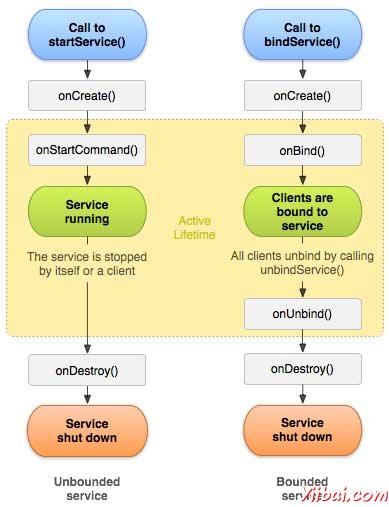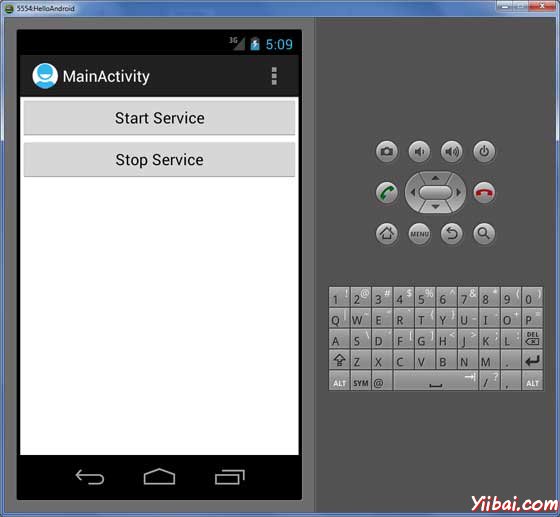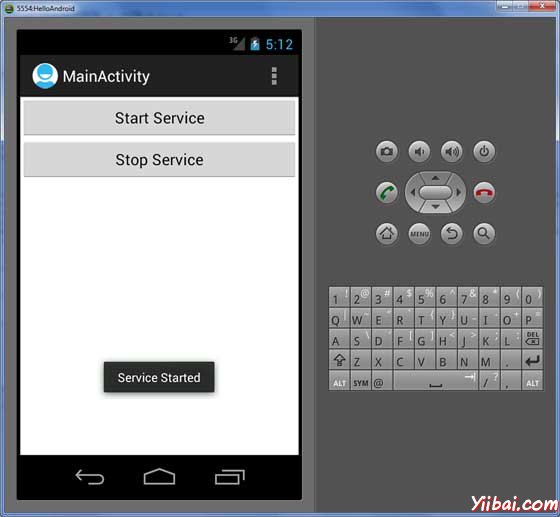Android Service
Service(服务)是一种在后台运行,执行长时间运行的操作,无需与用户交互的组件。例如,一个服务可以在后台播放音乐,用户在不同的应用程序或者可能通过网络获取数据,而不阻塞用户交互活动。本质上,一个服务可以采取两种状态:
| 状态 | 描述 |
|---|---|
| Started | 当一个应用程序组件,如活动,开始通过调用StartService()启动一个服务。开始以后服务可以无限期地在后台运行,即使启动它的组件被破坏。 |
| Bound | 当一个应用程序组件绑定调用bindService()方法绑定服务。绑定服务提供客户端 - 服务器的接口,允许组件进行交互的服务,发送请求,得到结果,这样可以跨进程进程间通信(IPC)。 |
每个服务都具有生命周期回调方法,可以实现监视服务的状态变化,并在适当的阶段执行工作。下图左侧显示的整个生命周期由StartService()创建提供服务 ,右边的图显示bindService()创建的整个生命周期提供服务:

要创建一个服务,需要创建一个Java类,扩展Service基类或者它的子类。Service基类定义各种回调方法,如下面表格给出。但是也并不需要实现所有的回调方法。重要的是要了解每一个变化以及实现,以确保应用程序能如用户所期望的行为方式运行。
| 回调 | 描述 |
|---|---|
| onStartCommand() | 系统调用此方法当另一组件,如一个活动,通过调用startService()要求该服务启动。如果要实现方法,它工作完成后停止服务,通过调用stopSelf()或stopService()方法。 |
| onBind() | 该系统调用这个方法当其他组件要通过调用bindService()绑定服务。如果实现此方法,必须提供客户端与服务进行通信,通过返回一个IBinder对象的接口。必须实现此方法,但如果不希望被绑定,那么应该返回null。 |
| onUnbind() | 系统调用此方法,当所有客户都从服务发布的特定接口断开。 |
| onRebind() | 该系统调用这个方法时,新的客户端已连接到服务,它事先未通知,所有已经上解除绑定后(意向)断开它。 |
| onCreate() | 该系统调用时,使用onStartCommand()或onBind()首先创建的服务这个方法。此调用需要执行一次性安装。 |
| onDestroy() | 系统调用这个方法当服务不再使用(被销毁)。服务应该实现这个用于清理,如线程,注册的侦听器,接收器等任何资源 |
下面的主服务演示每一个方法生命周期:
package com.yiibai; import android.app.Service; import android.os.IBinder; import android.content.Intent; import android.os.Bundle; public class HelloService extends Service { /** indicates how to behave if the service is killed */ int mStartMode; /** interface for clients that bind */ IBinder mBinder; /** indicates whether onRebind should be used */ boolean mAllowRebind; /** Called when the service is being created. */ @Override public void onCreate() { } /** The service is starting, due to a call to startService() */ @Override public int onStartCommand(Intent intent, int flags, int startId) { return mStartMode; } /** A client is binding to the service with bindService() */ @Override public IBinder onBind(Intent intent) { return mBinder; } /** Called when all clients have unbound with unbindService() */ @Override public boolean onUnbind(Intent intent) { return mAllowRebind; } /** Called when a client is binding to the service with bindService()*/ @Override public void onRebind(Intent intent) { } /** Called when The service is no longer used and is being destroyed */ @Override public void onDestroy() { } }
示例
这个例子将通过简单的步骤显示了如何创建Android服务。按照下面的步骤来修改前面章节创建的Android应用程序 - Hello World示例 :
| 步骤 | 描述 |
|---|---|
| 1 | 使用Eclipse IDE创建Android应用程序,并将其命名为HelloWorld在包com.example.helloworld下,类似Hello World示例章节中一样。 |
| 2 | 修改主要活动文件MainActivity.java添加startService()和stopService()方法。 |
| 3 | 在包com.example.helloworld下创建一个新的Java文件MyService.java。该文件将有实现Android服务相关的方法。 |
| 4 | 使用 <service.../>标签定义AndroidManifest.xml文件服务。一个应用可以有一个或多个服务,没有任何限制。 |
| 5 | 修改res/layout/activity_main.xml文件的默认内容包括线性布局中的两个按钮。 |
| 6 | 定义两个常量start_service和stop_service在 res/values/strings.xml 文件中 |
| 7 | 运行该应用程序启动Android模拟器并验证应用程序所做的修改结果。 |
以下是改性主要活动文件 src/com.example.helloworld/MainActivity.java 的内容。这个文件包括每个基本的生命周期方法。添加 StartService() 和 stopService() 方法来启动和停止服务。
package com.example.helloworld; import android.os.Bundle; import android.app.Activity; import android.view.Menu; import android.content.Intent; import android.view.View; public class MainActivity extends Activity { @Override public void onCreate(Bundle savedInstanceState) { super.onCreate(savedInstanceState); setContentView(R.layout.activity_main); } @Override public boolean onCreateOptionsMenu(Menu menu) { getMenuInflater().inflate(R.menu.activity_main, menu); return true; } // Method to start the service public void startService(View view) { startService(new Intent(getBaseContext(), MyService.class)); } // Method to stop the service public void stopService(View view) { stopService(new Intent(getBaseContext(), MyService.class)); } }
以下是src/com.example.helloworld/MyService.java 的内容。这个文件可以有一个或多个方法来使用服务。现在要实现只有两个方法 onStartCommand() 和 onDestroy() :
package com.example.helloworld; import android.app.Service; import android.content.Intent; import android.os.IBinder; import android.widget.Toast; public class MyService extends Service { @Override public IBinder onBind(Intent arg0) { return null; } @Override public int onStartCommand(Intent intent, int flags, int startId) { // Let it continue running until it is stopped. Toast.makeText(this, "Service Started", Toast.LENGTH_LONG).show(); return START_STICKY; } @Override public void onDestroy() { super.onDestroy(); Toast.makeText(this, "Service Destroyed", Toast.LENGTH_LONG).show(); } }
下面将 AndroidManifest.xml 文件的内容修改。在这里添加 <service.../> 标签,包括服务:
<manifest xmlns:android="http://schemas.android.com/apk/res/android" package="com.example.helloworld" android:versionCode="1" android:versionName="1.0" > <uses-sdk android:minSdkVersion="8" android:targetSdkVersion="15" /> <application android:icon="@drawable/ic_launcher" android:label="@string/app_name" android:theme="@style/AppTheme" > <activity android:name=".MainActivity" android:label="@string/title_activity_main" > <intent-filter> <action android:name="android.intent.action.MAIN" /> <category android:name="android.intent.category.LAUNCHER"/> </intent-filter> </activity> <service android:name=".MyService" /> </application> </manifest>
将以下是 res/layout/activity_main.xml 文件的内容,包括两个按钮:
<LinearLayout xmlns:android="http://schemas.android.com/apk/res/android" android:layout_width="fill_parent" android:layout_height="fill_parent" android:orientation="vertical" > <Button android:id="@+id/btnStartService" android:layout_width="fill_parent" android:layout_height="wrap_content" android:text="@string/start_service" android:onClick="startService"/> <Button android:id="@+id/btnStopService" android:layout_width="fill_parent" android:layout_height="wrap_content" android:text="@string/stop_service" android:onClick="stopService" /> </LinearLayout>
下面将在 res/values/strings.xml 中定义两个新的常量:
<resources> <string name="app_name">HelloWorld</string> <string name="hello_world">Hello world!</string> <string name="menu_settings">Settings</string> <string name="title_activity_main">MainActivity</string> <string name="start_service">Start Service</string> <string name="stop_service">Stop Service</string> </resources>
现在运行修改后的 Hello World!应用程序。假设创建了AVD 并同时做了环境设置。要在Eclipse运行的应用程序,打开一个项目的活动文件,从工具栏上找到并单击 “run”  图标。 Eclipse AVD上安装的应用程序,并启动它,如果一切设置以及应用都没有问题,那么将会显示以下模拟器窗口:
图标。 Eclipse AVD上安装的应用程序,并启动它,如果一切设置以及应用都没有问题,那么将会显示以下模拟器窗口:

要开始服务,现在就点击启动服务按钮,onStartCommand() 方法在程序中,每一个服务开始后将出现消息在模拟器底部,如下:

要停止该服务,可以点击停止服务(Stop Service)按钮。

